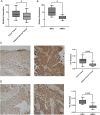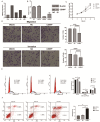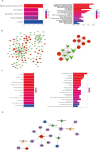CENPF overexpression in bladder cancer cells enhances proliferation, migration, invasion, and apoptosis
- PMID: 40659783
- PMCID: PMC12259981
- DOI: 10.1038/s41598-025-10677-9
CENPF overexpression in bladder cancer cells enhances proliferation, migration, invasion, and apoptosis
Abstract
Bladder cancer has been considered as one of the most common urinary malignancies. Growing evidence has indicated that Centromere Protein F (CENPF) is a promising molecular biomarker for many human malignant tumors. However, the role of CENPF in bladder cancer (BC) proliferation, migration, invasion, cell cycle and apoptosis thereof remain unclear. In the present study, high-throughput sequencing technology and bioinformatics analysis were conducted to identify mRNAs profiles in 10 pairs of bladder cancer tissues and adjacent noncancerous tissues. CENPF was overexpression in bladder cancer tissues, and higher in MIBC than NMIBC. We investigated the expression of CENPF in 30 other pairs bladder cancers tissues, and the results were in accordance with the sequencing results. Furthermore, Immunohistochemical staining, showed that strong intensity of CENPF in BC tissues than normal tissues. Increased staining of CENPF was detected of tumor cells in MIBC compared with NMIBC. This suggests that CENPF might be highly expressed in aggressive and invasive tumor cells. Subsequently, in vitro functional experiments also demonstrated that the siRNA interference of CENPF expression significantly weakened the proliferation, migration, invasion and apoptosis of BC cells, and the cells were arrested in the G2/S phase in Cell cycle. Moreover, functional enrichment analyses, lncRNA-miRNA-mRNA, and protein-protein interaction networks revealed that CENPF was potentially involved in carcinogenesis and evolution of bladder cancer. Taken together, these results demonstrated that CENPF may serve as a potential biomarker of tumor occurrence, progression, and even prognosis for bladder cancer. However, further research is needed to be further clarified the pathway mechanisms of CENPF in bladder cancer.
Keywords: Biomarker; Bladder cancer; CENPF; Cell functional experiments.
© 2025. The Author(s).
Conflict of interest statement
Competing interests: The authors declare no competing interests. Ethical approval: All methods were performed in accordance with the relevant guidelines and regulations. This paper does not engage in animal experimentation or involve any animal ethics.
Figures




Similar articles
-
Opa interacting protein 5 acts as an oncogene in bladder cancer.J Cancer Res Clin Oncol. 2017 Nov;143(11):2221-2233. doi: 10.1007/s00432-017-2485-4. Epub 2017 Jul 27. J Cancer Res Clin Oncol. 2017. PMID: 28752236 Free PMC article.
-
Caveolin-1 inhibits the proliferation and invasion of lung adenocarcinoma via EGFR degradation.Sci Rep. 2025 Jul 1;15(1):21654. doi: 10.1038/s41598-025-05259-8. Sci Rep. 2025. PMID: 40594106 Free PMC article.
-
Multi-omics analysis unveils the predictive value of IGF2BP3/SPHK1 signaling in cancer stem cells for prognosis and immunotherapeutic response in muscle-invasive bladder cancer.J Transl Med. 2024 Oct 4;22(1):900. doi: 10.1186/s12967-024-05685-8. J Transl Med. 2024. PMID: 39367493 Free PMC article.
-
Intravesical gemcitabine therapy for non-muscle invasive bladder cancer (NMIBC): a systematic review.BJU Int. 2012 Feb;109(4):496-505. doi: 10.1111/j.1464-410X.2011.10880.x. BJU Int. 2012. PMID: 22313502
-
Intravesical gemcitabine for non-muscle invasive bladder cancer.Cochrane Database Syst Rev. 2012 Jan 18;1:CD009294. doi: 10.1002/14651858.CD009294.pub2. Cochrane Database Syst Rev. 2012. Update in: Cochrane Database Syst Rev. 2021 Jun 14;6:CD009294. doi: 10.1002/14651858.CD009294.pub3. PMID: 22259002 Updated.
References
-
- Contieri, R. et al. Accuracy of the European association of urology (EAU) NMIBC 2021 scoring model in predicting progression in a large cohort of HG T1 NMIBC patients treated with BCG. Minerva Urol. Nephrol.75, 180–187. 10.23736/s2724-6051.22.04953-9 (2023). - PubMed
-
- Babjuk, M. et al. European association of urology guidelines on Non-muscle-invasive bladder Cancer (Ta, T1, and carcinoma in Situ). Eur. Urol.81, 75–94. 10.1016/j.eururo.2021.08.010 (2022). - PubMed
-
- Cathomas, R. et al. The 2021 updated European association of urology guidelines on metastatic urothelial carcinoma. Eur. Urol.81, 95–103. 10.1016/j.eururo.2021.09.026 (2022). - PubMed
MeSH terms
Substances
Grants and funding
LinkOut - more resources
Full Text Sources
Medical

